Power and Politics in the Organization: Hofstede Model Analysis
VerifiedAdded on 2021/04/17
|11
|2892
|151
Essay
AI Summary
This essay delves into the intricate relationship between power and politics within organizations. It begins by defining power as the ability to influence others and emphasizes its importance in driving change and productivity, while also acknowledging the potential for misuse. The essay then provides an overview of Hofstede's cultural dimensions theory, detailing its six dimensions and their impact on organizational behavior and communication. It further explores the five sources of power—coercive, legitimate, expert, referent, and reward—and their implications for employee motivation and control. The core of the essay applies the Hofstede model to change management, examining how cultural dimensions such as power distance, individualism, masculinity, uncertainty avoidance, long-term orientation, and indulgence influence perceptions of change and its successful implementation. It concludes by highlighting the significance of understanding cultural nuances for effective leadership and change management strategies, underscoring the need for leaders to adapt their approach based on cultural expectations and the potential challenges that arise during organizational change.
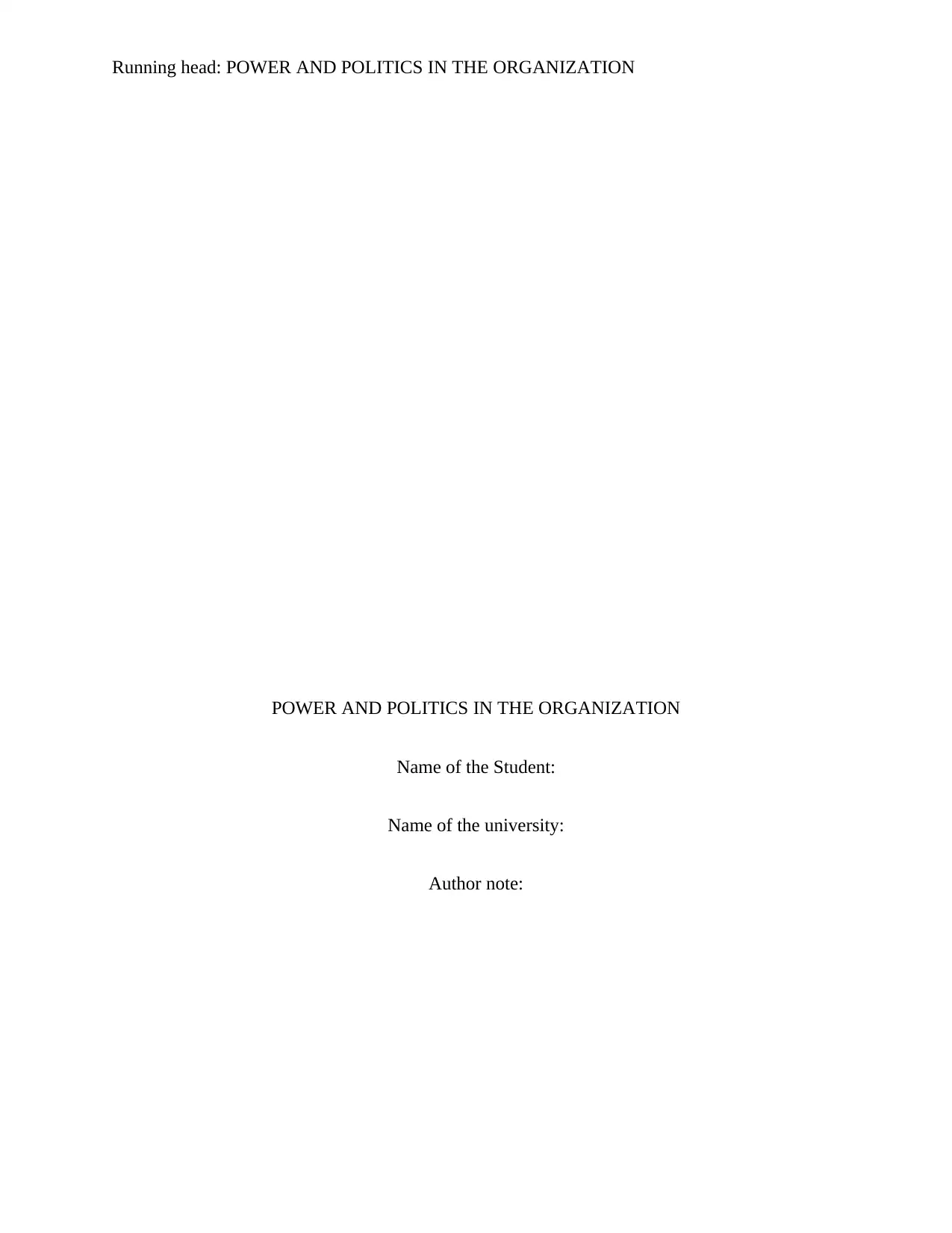
Running head: POWER AND POLITICS IN THE ORGANIZATION
POWER AND POLITICS IN THE ORGANIZATION
Name of the Student:
Name of the university:
Author note:
POWER AND POLITICS IN THE ORGANIZATION
Name of the Student:
Name of the university:
Author note:
Paraphrase This Document
Need a fresh take? Get an instant paraphrase of this document with our AI Paraphraser
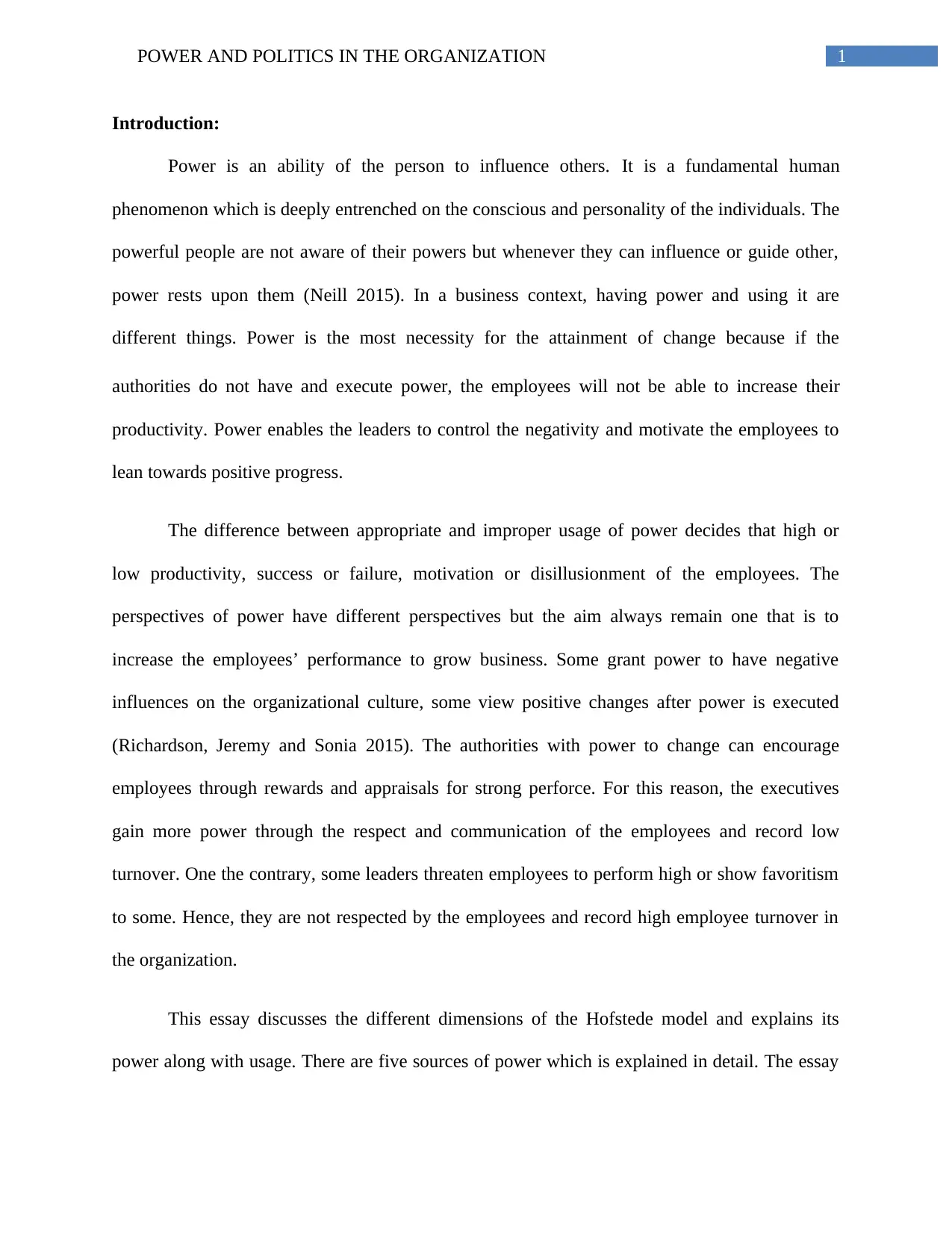
1POWER AND POLITICS IN THE ORGANIZATION
Introduction:
Power is an ability of the person to influence others. It is a fundamental human
phenomenon which is deeply entrenched on the conscious and personality of the individuals. The
powerful people are not aware of their powers but whenever they can influence or guide other,
power rests upon them (Neill 2015). In a business context, having power and using it are
different things. Power is the most necessity for the attainment of change because if the
authorities do not have and execute power, the employees will not be able to increase their
productivity. Power enables the leaders to control the negativity and motivate the employees to
lean towards positive progress.
The difference between appropriate and improper usage of power decides that high or
low productivity, success or failure, motivation or disillusionment of the employees. The
perspectives of power have different perspectives but the aim always remain one that is to
increase the employees’ performance to grow business. Some grant power to have negative
influences on the organizational culture, some view positive changes after power is executed
(Richardson, Jeremy and Sonia 2015). The authorities with power to change can encourage
employees through rewards and appraisals for strong perforce. For this reason, the executives
gain more power through the respect and communication of the employees and record low
turnover. One the contrary, some leaders threaten employees to perform high or show favoritism
to some. Hence, they are not respected by the employees and record high employee turnover in
the organization.
This essay discusses the different dimensions of the Hofstede model and explains its
power along with usage. There are five sources of power which is explained in detail. The essay
Introduction:
Power is an ability of the person to influence others. It is a fundamental human
phenomenon which is deeply entrenched on the conscious and personality of the individuals. The
powerful people are not aware of their powers but whenever they can influence or guide other,
power rests upon them (Neill 2015). In a business context, having power and using it are
different things. Power is the most necessity for the attainment of change because if the
authorities do not have and execute power, the employees will not be able to increase their
productivity. Power enables the leaders to control the negativity and motivate the employees to
lean towards positive progress.
The difference between appropriate and improper usage of power decides that high or
low productivity, success or failure, motivation or disillusionment of the employees. The
perspectives of power have different perspectives but the aim always remain one that is to
increase the employees’ performance to grow business. Some grant power to have negative
influences on the organizational culture, some view positive changes after power is executed
(Richardson, Jeremy and Sonia 2015). The authorities with power to change can encourage
employees through rewards and appraisals for strong perforce. For this reason, the executives
gain more power through the respect and communication of the employees and record low
turnover. One the contrary, some leaders threaten employees to perform high or show favoritism
to some. Hence, they are not respected by the employees and record high employee turnover in
the organization.
This essay discusses the different dimensions of the Hofstede model and explains its
power along with usage. There are five sources of power which is explained in detail. The essay
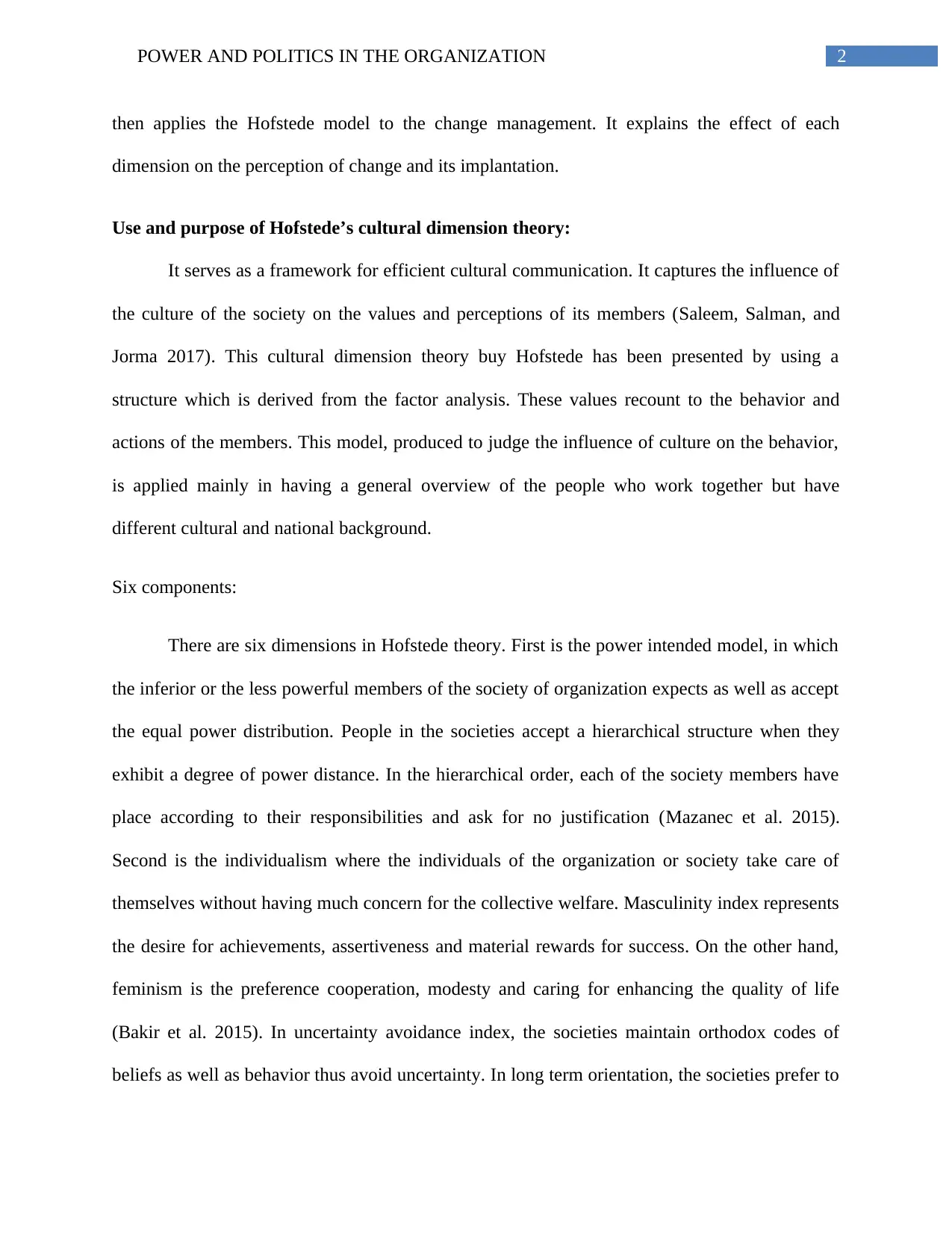
2POWER AND POLITICS IN THE ORGANIZATION
then applies the Hofstede model to the change management. It explains the effect of each
dimension on the perception of change and its implantation.
Use and purpose of Hofstede’s cultural dimension theory:
It serves as a framework for efficient cultural communication. It captures the influence of
the culture of the society on the values and perceptions of its members (Saleem, Salman, and
Jorma 2017). This cultural dimension theory buy Hofstede has been presented by using a
structure which is derived from the factor analysis. These values recount to the behavior and
actions of the members. This model, produced to judge the influence of culture on the behavior,
is applied mainly in having a general overview of the people who work together but have
different cultural and national background.
Six components:
There are six dimensions in Hofstede theory. First is the power intended model, in which
the inferior or the less powerful members of the society of organization expects as well as accept
the equal power distribution. People in the societies accept a hierarchical structure when they
exhibit a degree of power distance. In the hierarchical order, each of the society members have
place according to their responsibilities and ask for no justification (Mazanec et al. 2015).
Second is the individualism where the individuals of the organization or society take care of
themselves without having much concern for the collective welfare. Masculinity index represents
the desire for achievements, assertiveness and material rewards for success. On the other hand,
feminism is the preference cooperation, modesty and caring for enhancing the quality of life
(Bakir et al. 2015). In uncertainty avoidance index, the societies maintain orthodox codes of
beliefs as well as behavior thus avoid uncertainty. In long term orientation, the societies prefer to
then applies the Hofstede model to the change management. It explains the effect of each
dimension on the perception of change and its implantation.
Use and purpose of Hofstede’s cultural dimension theory:
It serves as a framework for efficient cultural communication. It captures the influence of
the culture of the society on the values and perceptions of its members (Saleem, Salman, and
Jorma 2017). This cultural dimension theory buy Hofstede has been presented by using a
structure which is derived from the factor analysis. These values recount to the behavior and
actions of the members. This model, produced to judge the influence of culture on the behavior,
is applied mainly in having a general overview of the people who work together but have
different cultural and national background.
Six components:
There are six dimensions in Hofstede theory. First is the power intended model, in which
the inferior or the less powerful members of the society of organization expects as well as accept
the equal power distribution. People in the societies accept a hierarchical structure when they
exhibit a degree of power distance. In the hierarchical order, each of the society members have
place according to their responsibilities and ask for no justification (Mazanec et al. 2015).
Second is the individualism where the individuals of the organization or society take care of
themselves without having much concern for the collective welfare. Masculinity index represents
the desire for achievements, assertiveness and material rewards for success. On the other hand,
feminism is the preference cooperation, modesty and caring for enhancing the quality of life
(Bakir et al. 2015). In uncertainty avoidance index, the societies maintain orthodox codes of
beliefs as well as behavior thus avoid uncertainty. In long term orientation, the societies prefer to
⊘ This is a preview!⊘
Do you want full access?
Subscribe today to unlock all pages.

Trusted by 1+ million students worldwide
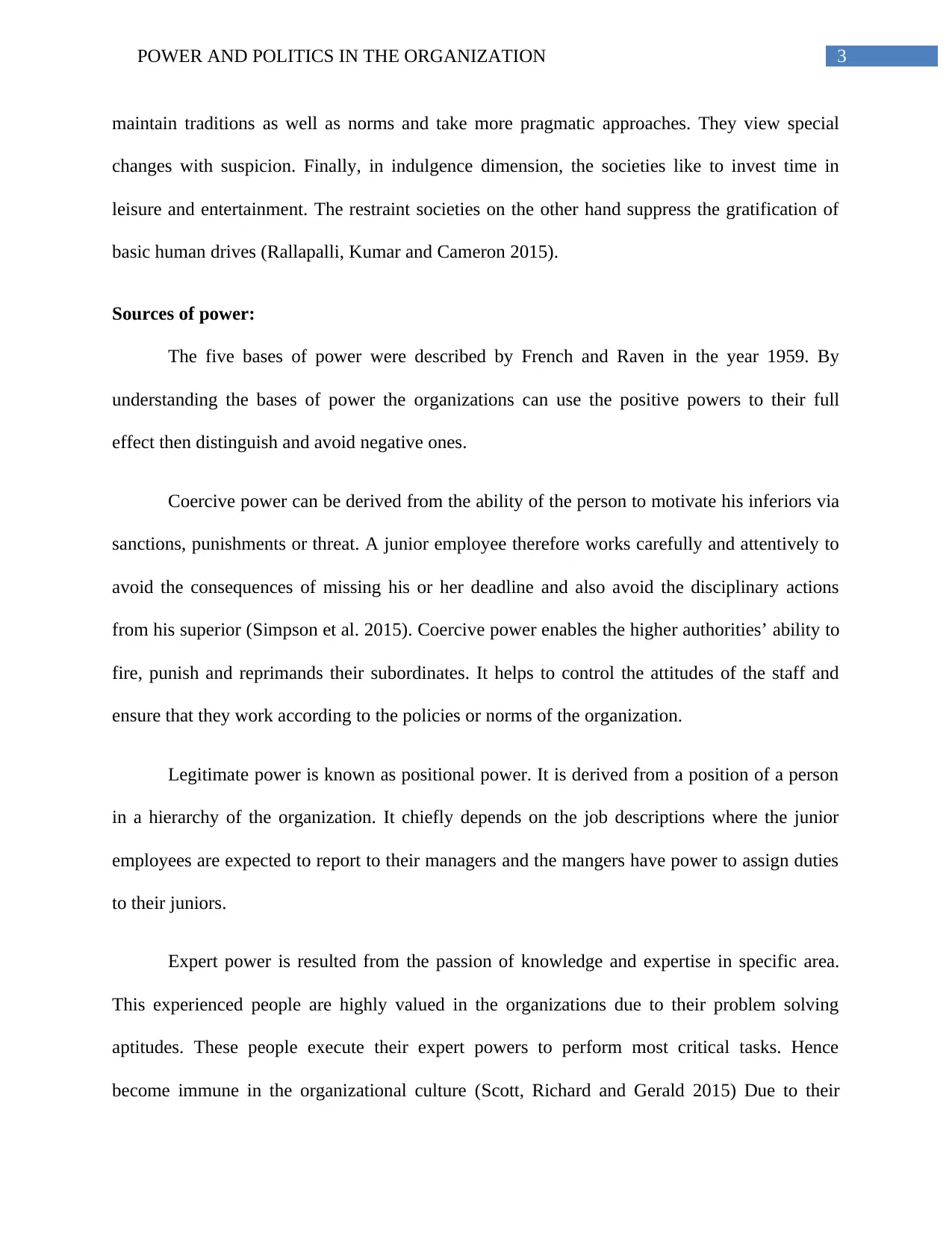
3POWER AND POLITICS IN THE ORGANIZATION
maintain traditions as well as norms and take more pragmatic approaches. They view special
changes with suspicion. Finally, in indulgence dimension, the societies like to invest time in
leisure and entertainment. The restraint societies on the other hand suppress the gratification of
basic human drives (Rallapalli, Kumar and Cameron 2015).
Sources of power:
The five bases of power were described by French and Raven in the year 1959. By
understanding the bases of power the organizations can use the positive powers to their full
effect then distinguish and avoid negative ones.
Coercive power can be derived from the ability of the person to motivate his inferiors via
sanctions, punishments or threat. A junior employee therefore works carefully and attentively to
avoid the consequences of missing his or her deadline and also avoid the disciplinary actions
from his superior (Simpson et al. 2015). Coercive power enables the higher authorities’ ability to
fire, punish and reprimands their subordinates. It helps to control the attitudes of the staff and
ensure that they work according to the policies or norms of the organization.
Legitimate power is known as positional power. It is derived from a position of a person
in a hierarchy of the organization. It chiefly depends on the job descriptions where the junior
employees are expected to report to their managers and the mangers have power to assign duties
to their juniors.
Expert power is resulted from the passion of knowledge and expertise in specific area.
This experienced people are highly valued in the organizations due to their problem solving
aptitudes. These people execute their expert powers to perform most critical tasks. Hence
become immune in the organizational culture (Scott, Richard and Gerald 2015) Due to their
maintain traditions as well as norms and take more pragmatic approaches. They view special
changes with suspicion. Finally, in indulgence dimension, the societies like to invest time in
leisure and entertainment. The restraint societies on the other hand suppress the gratification of
basic human drives (Rallapalli, Kumar and Cameron 2015).
Sources of power:
The five bases of power were described by French and Raven in the year 1959. By
understanding the bases of power the organizations can use the positive powers to their full
effect then distinguish and avoid negative ones.
Coercive power can be derived from the ability of the person to motivate his inferiors via
sanctions, punishments or threat. A junior employee therefore works carefully and attentively to
avoid the consequences of missing his or her deadline and also avoid the disciplinary actions
from his superior (Simpson et al. 2015). Coercive power enables the higher authorities’ ability to
fire, punish and reprimands their subordinates. It helps to control the attitudes of the staff and
ensure that they work according to the policies or norms of the organization.
Legitimate power is known as positional power. It is derived from a position of a person
in a hierarchy of the organization. It chiefly depends on the job descriptions where the junior
employees are expected to report to their managers and the mangers have power to assign duties
to their juniors.
Expert power is resulted from the passion of knowledge and expertise in specific area.
This experienced people are highly valued in the organizations due to their problem solving
aptitudes. These people execute their expert powers to perform most critical tasks. Hence
become immune in the organizational culture (Scott, Richard and Gerald 2015) Due to their
Paraphrase This Document
Need a fresh take? Get an instant paraphrase of this document with our AI Paraphraser
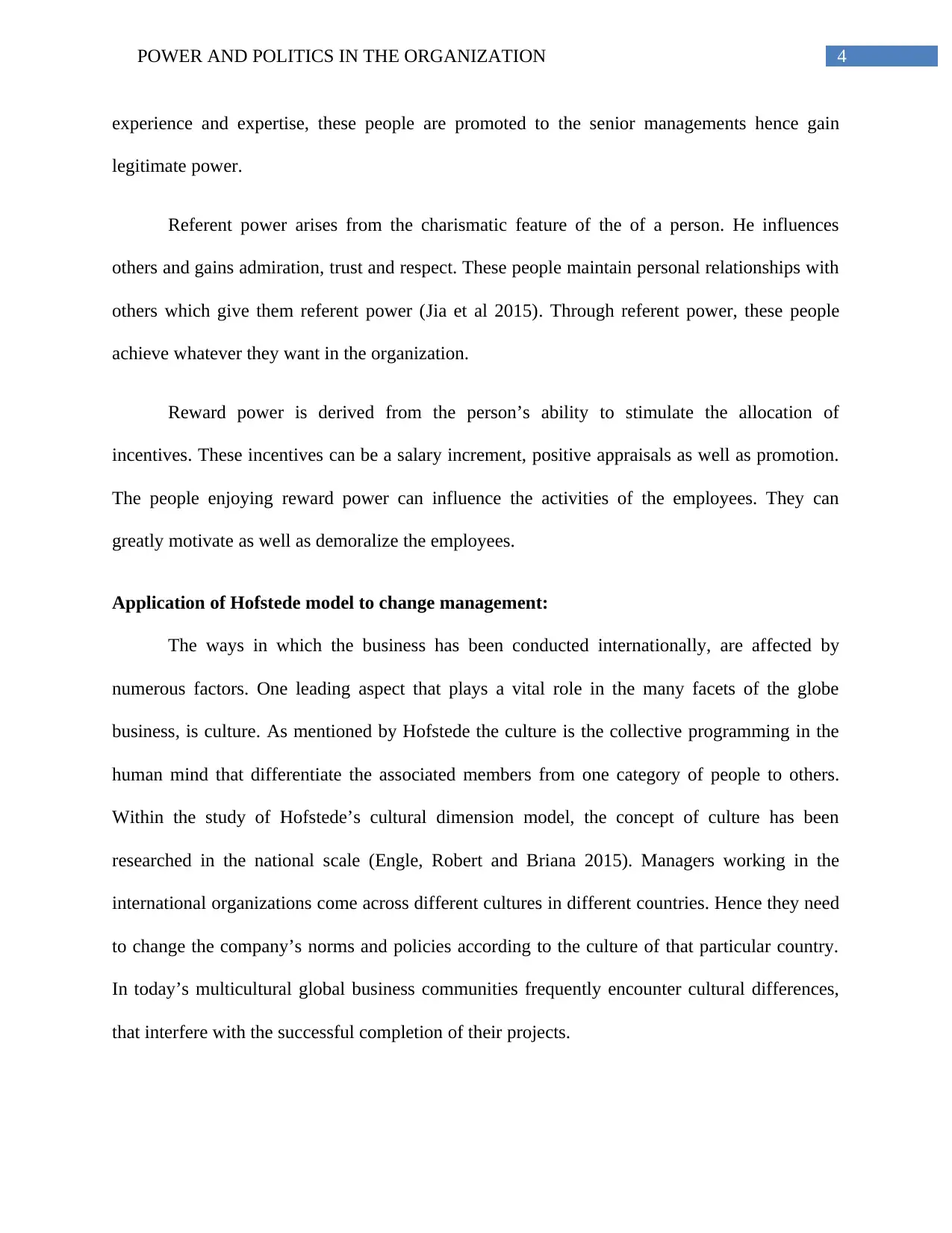
4POWER AND POLITICS IN THE ORGANIZATION
experience and expertise, these people are promoted to the senior managements hence gain
legitimate power.
Referent power arises from the charismatic feature of the of a person. He influences
others and gains admiration, trust and respect. These people maintain personal relationships with
others which give them referent power (Jia et al 2015). Through referent power, these people
achieve whatever they want in the organization.
Reward power is derived from the person’s ability to stimulate the allocation of
incentives. These incentives can be a salary increment, positive appraisals as well as promotion.
The people enjoying reward power can influence the activities of the employees. They can
greatly motivate as well as demoralize the employees.
Application of Hofstede model to change management:
The ways in which the business has been conducted internationally, are affected by
numerous factors. One leading aspect that plays a vital role in the many facets of the globe
business, is culture. As mentioned by Hofstede the culture is the collective programming in the
human mind that differentiate the associated members from one category of people to others.
Within the study of Hofstede’s cultural dimension model, the concept of culture has been
researched in the national scale (Engle, Robert and Briana 2015). Managers working in the
international organizations come across different cultures in different countries. Hence they need
to change the company’s norms and policies according to the culture of that particular country.
In today’s multicultural global business communities frequently encounter cultural differences,
that interfere with the successful completion of their projects.
experience and expertise, these people are promoted to the senior managements hence gain
legitimate power.
Referent power arises from the charismatic feature of the of a person. He influences
others and gains admiration, trust and respect. These people maintain personal relationships with
others which give them referent power (Jia et al 2015). Through referent power, these people
achieve whatever they want in the organization.
Reward power is derived from the person’s ability to stimulate the allocation of
incentives. These incentives can be a salary increment, positive appraisals as well as promotion.
The people enjoying reward power can influence the activities of the employees. They can
greatly motivate as well as demoralize the employees.
Application of Hofstede model to change management:
The ways in which the business has been conducted internationally, are affected by
numerous factors. One leading aspect that plays a vital role in the many facets of the globe
business, is culture. As mentioned by Hofstede the culture is the collective programming in the
human mind that differentiate the associated members from one category of people to others.
Within the study of Hofstede’s cultural dimension model, the concept of culture has been
researched in the national scale (Engle, Robert and Briana 2015). Managers working in the
international organizations come across different cultures in different countries. Hence they need
to change the company’s norms and policies according to the culture of that particular country.
In today’s multicultural global business communities frequently encounter cultural differences,
that interfere with the successful completion of their projects.
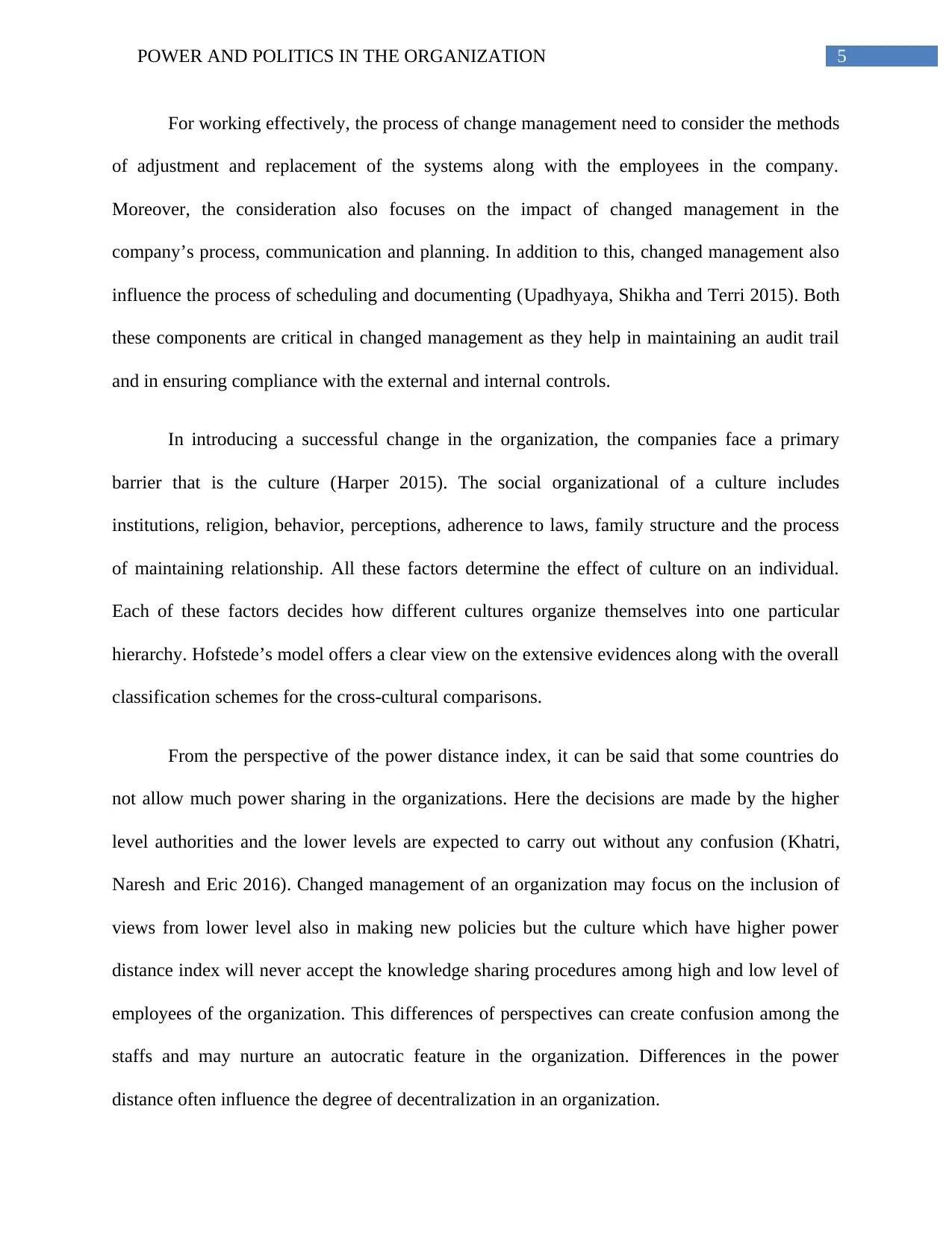
5POWER AND POLITICS IN THE ORGANIZATION
For working effectively, the process of change management need to consider the methods
of adjustment and replacement of the systems along with the employees in the company.
Moreover, the consideration also focuses on the impact of changed management in the
company’s process, communication and planning. In addition to this, changed management also
influence the process of scheduling and documenting (Upadhyaya, Shikha and Terri 2015). Both
these components are critical in changed management as they help in maintaining an audit trail
and in ensuring compliance with the external and internal controls.
In introducing a successful change in the organization, the companies face a primary
barrier that is the culture (Harper 2015). The social organizational of a culture includes
institutions, religion, behavior, perceptions, adherence to laws, family structure and the process
of maintaining relationship. All these factors determine the effect of culture on an individual.
Each of these factors decides how different cultures organize themselves into one particular
hierarchy. Hofstede’s model offers a clear view on the extensive evidences along with the overall
classification schemes for the cross-cultural comparisons.
From the perspective of the power distance index, it can be said that some countries do
not allow much power sharing in the organizations. Here the decisions are made by the higher
level authorities and the lower levels are expected to carry out without any confusion (Khatri,
Naresh and Eric 2016). Changed management of an organization may focus on the inclusion of
views from lower level also in making new policies but the culture which have higher power
distance index will never accept the knowledge sharing procedures among high and low level of
employees of the organization. This differences of perspectives can create confusion among the
staffs and may nurture an autocratic feature in the organization. Differences in the power
distance often influence the degree of decentralization in an organization.
For working effectively, the process of change management need to consider the methods
of adjustment and replacement of the systems along with the employees in the company.
Moreover, the consideration also focuses on the impact of changed management in the
company’s process, communication and planning. In addition to this, changed management also
influence the process of scheduling and documenting (Upadhyaya, Shikha and Terri 2015). Both
these components are critical in changed management as they help in maintaining an audit trail
and in ensuring compliance with the external and internal controls.
In introducing a successful change in the organization, the companies face a primary
barrier that is the culture (Harper 2015). The social organizational of a culture includes
institutions, religion, behavior, perceptions, adherence to laws, family structure and the process
of maintaining relationship. All these factors determine the effect of culture on an individual.
Each of these factors decides how different cultures organize themselves into one particular
hierarchy. Hofstede’s model offers a clear view on the extensive evidences along with the overall
classification schemes for the cross-cultural comparisons.
From the perspective of the power distance index, it can be said that some countries do
not allow much power sharing in the organizations. Here the decisions are made by the higher
level authorities and the lower levels are expected to carry out without any confusion (Khatri,
Naresh and Eric 2016). Changed management of an organization may focus on the inclusion of
views from lower level also in making new policies but the culture which have higher power
distance index will never accept the knowledge sharing procedures among high and low level of
employees of the organization. This differences of perspectives can create confusion among the
staffs and may nurture an autocratic feature in the organization. Differences in the power
distance often influence the degree of decentralization in an organization.
⊘ This is a preview!⊘
Do you want full access?
Subscribe today to unlock all pages.

Trusted by 1+ million students worldwide
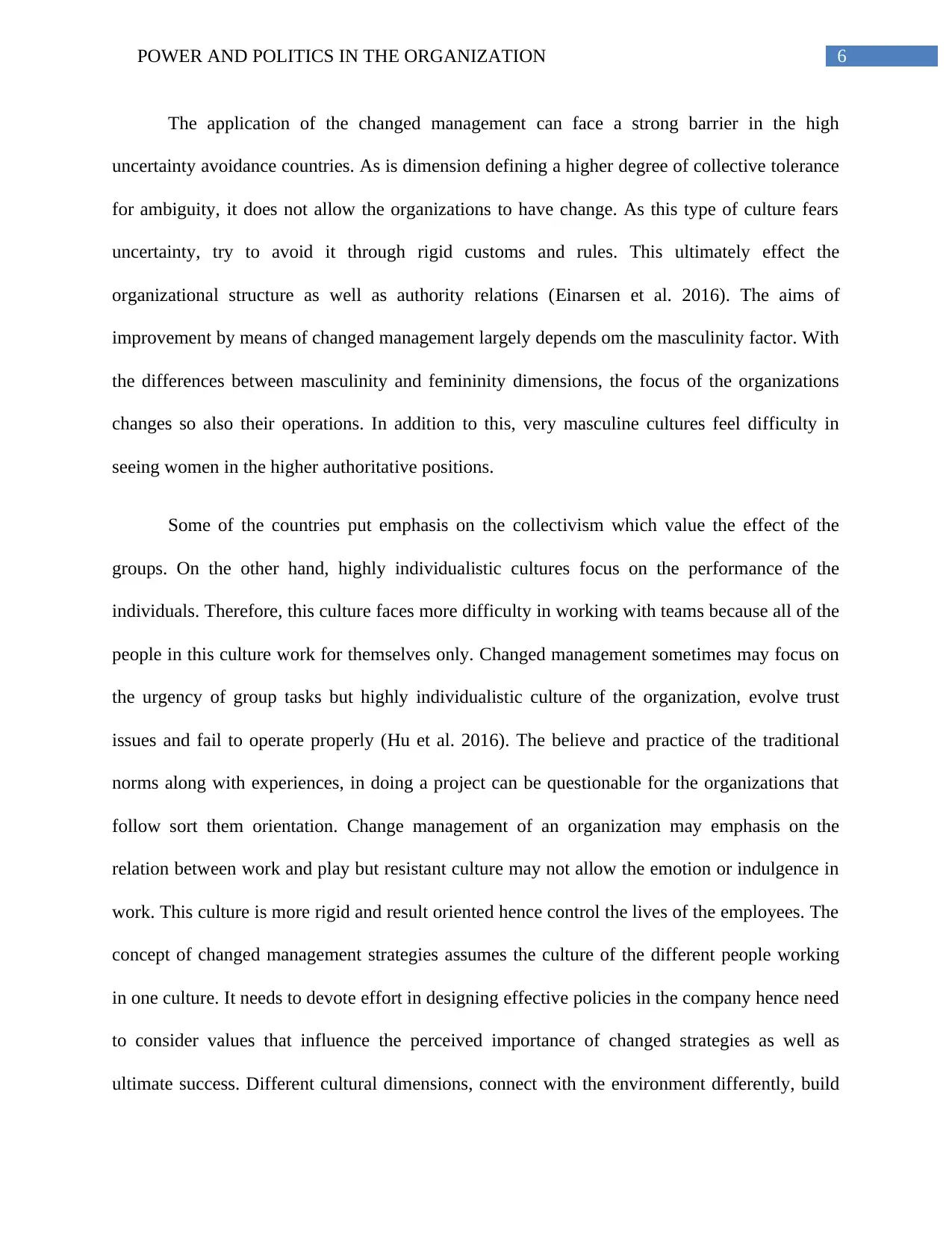
6POWER AND POLITICS IN THE ORGANIZATION
The application of the changed management can face a strong barrier in the high
uncertainty avoidance countries. As is dimension defining a higher degree of collective tolerance
for ambiguity, it does not allow the organizations to have change. As this type of culture fears
uncertainty, try to avoid it through rigid customs and rules. This ultimately effect the
organizational structure as well as authority relations (Einarsen et al. 2016). The aims of
improvement by means of changed management largely depends om the masculinity factor. With
the differences between masculinity and femininity dimensions, the focus of the organizations
changes so also their operations. In addition to this, very masculine cultures feel difficulty in
seeing women in the higher authoritative positions.
Some of the countries put emphasis on the collectivism which value the effect of the
groups. On the other hand, highly individualistic cultures focus on the performance of the
individuals. Therefore, this culture faces more difficulty in working with teams because all of the
people in this culture work for themselves only. Changed management sometimes may focus on
the urgency of group tasks but highly individualistic culture of the organization, evolve trust
issues and fail to operate properly (Hu et al. 2016). The believe and practice of the traditional
norms along with experiences, in doing a project can be questionable for the organizations that
follow sort them orientation. Change management of an organization may emphasis on the
relation between work and play but resistant culture may not allow the emotion or indulgence in
work. This culture is more rigid and result oriented hence control the lives of the employees. The
concept of changed management strategies assumes the culture of the different people working
in one culture. It needs to devote effort in designing effective policies in the company hence need
to consider values that influence the perceived importance of changed strategies as well as
ultimate success. Different cultural dimensions, connect with the environment differently, build
The application of the changed management can face a strong barrier in the high
uncertainty avoidance countries. As is dimension defining a higher degree of collective tolerance
for ambiguity, it does not allow the organizations to have change. As this type of culture fears
uncertainty, try to avoid it through rigid customs and rules. This ultimately effect the
organizational structure as well as authority relations (Einarsen et al. 2016). The aims of
improvement by means of changed management largely depends om the masculinity factor. With
the differences between masculinity and femininity dimensions, the focus of the organizations
changes so also their operations. In addition to this, very masculine cultures feel difficulty in
seeing women in the higher authoritative positions.
Some of the countries put emphasis on the collectivism which value the effect of the
groups. On the other hand, highly individualistic cultures focus on the performance of the
individuals. Therefore, this culture faces more difficulty in working with teams because all of the
people in this culture work for themselves only. Changed management sometimes may focus on
the urgency of group tasks but highly individualistic culture of the organization, evolve trust
issues and fail to operate properly (Hu et al. 2016). The believe and practice of the traditional
norms along with experiences, in doing a project can be questionable for the organizations that
follow sort them orientation. Change management of an organization may emphasis on the
relation between work and play but resistant culture may not allow the emotion or indulgence in
work. This culture is more rigid and result oriented hence control the lives of the employees. The
concept of changed management strategies assumes the culture of the different people working
in one culture. It needs to devote effort in designing effective policies in the company hence need
to consider values that influence the perceived importance of changed strategies as well as
ultimate success. Different cultural dimensions, connect with the environment differently, build
Paraphrase This Document
Need a fresh take? Get an instant paraphrase of this document with our AI Paraphraser
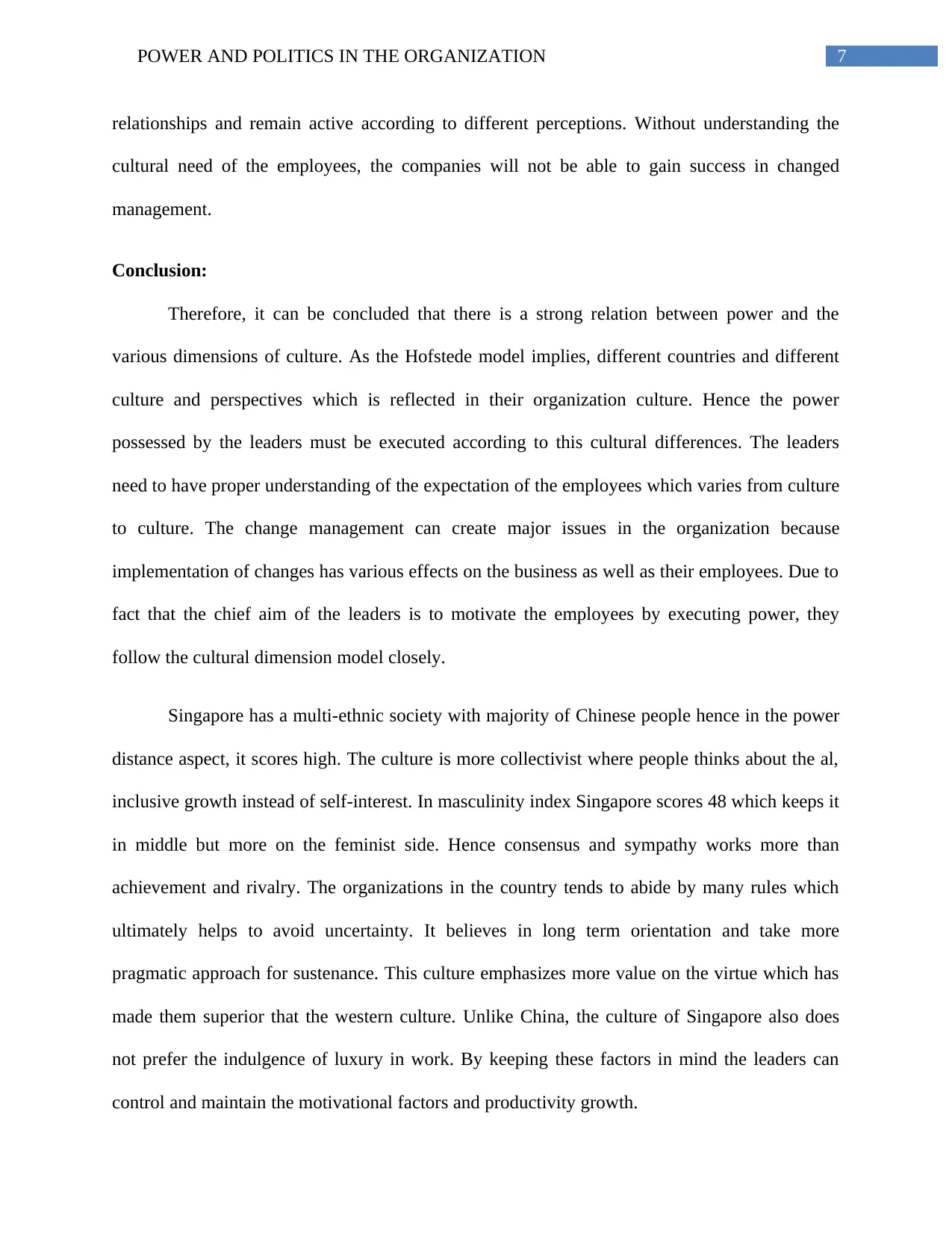
7POWER AND POLITICS IN THE ORGANIZATION
relationships and remain active according to different perceptions. Without understanding the
cultural need of the employees, the companies will not be able to gain success in changed
management.
Conclusion:
Therefore, it can be concluded that there is a strong relation between power and the
various dimensions of culture. As the Hofstede model implies, different countries and different
culture and perspectives which is reflected in their organization culture. Hence the power
possessed by the leaders must be executed according to this cultural differences. The leaders
need to have proper understanding of the expectation of the employees which varies from culture
to culture. The change management can create major issues in the organization because
implementation of changes has various effects on the business as well as their employees. Due to
fact that the chief aim of the leaders is to motivate the employees by executing power, they
follow the cultural dimension model closely.
Singapore has a multi-ethnic society with majority of Chinese people hence in the power
distance aspect, it scores high. The culture is more collectivist where people thinks about the al,
inclusive growth instead of self-interest. In masculinity index Singapore scores 48 which keeps it
in middle but more on the feminist side. Hence consensus and sympathy works more than
achievement and rivalry. The organizations in the country tends to abide by many rules which
ultimately helps to avoid uncertainty. It believes in long term orientation and take more
pragmatic approach for sustenance. This culture emphasizes more value on the virtue which has
made them superior that the western culture. Unlike China, the culture of Singapore also does
not prefer the indulgence of luxury in work. By keeping these factors in mind the leaders can
control and maintain the motivational factors and productivity growth.
relationships and remain active according to different perceptions. Without understanding the
cultural need of the employees, the companies will not be able to gain success in changed
management.
Conclusion:
Therefore, it can be concluded that there is a strong relation between power and the
various dimensions of culture. As the Hofstede model implies, different countries and different
culture and perspectives which is reflected in their organization culture. Hence the power
possessed by the leaders must be executed according to this cultural differences. The leaders
need to have proper understanding of the expectation of the employees which varies from culture
to culture. The change management can create major issues in the organization because
implementation of changes has various effects on the business as well as their employees. Due to
fact that the chief aim of the leaders is to motivate the employees by executing power, they
follow the cultural dimension model closely.
Singapore has a multi-ethnic society with majority of Chinese people hence in the power
distance aspect, it scores high. The culture is more collectivist where people thinks about the al,
inclusive growth instead of self-interest. In masculinity index Singapore scores 48 which keeps it
in middle but more on the feminist side. Hence consensus and sympathy works more than
achievement and rivalry. The organizations in the country tends to abide by many rules which
ultimately helps to avoid uncertainty. It believes in long term orientation and take more
pragmatic approach for sustenance. This culture emphasizes more value on the virtue which has
made them superior that the western culture. Unlike China, the culture of Singapore also does
not prefer the indulgence of luxury in work. By keeping these factors in mind the leaders can
control and maintain the motivational factors and productivity growth.
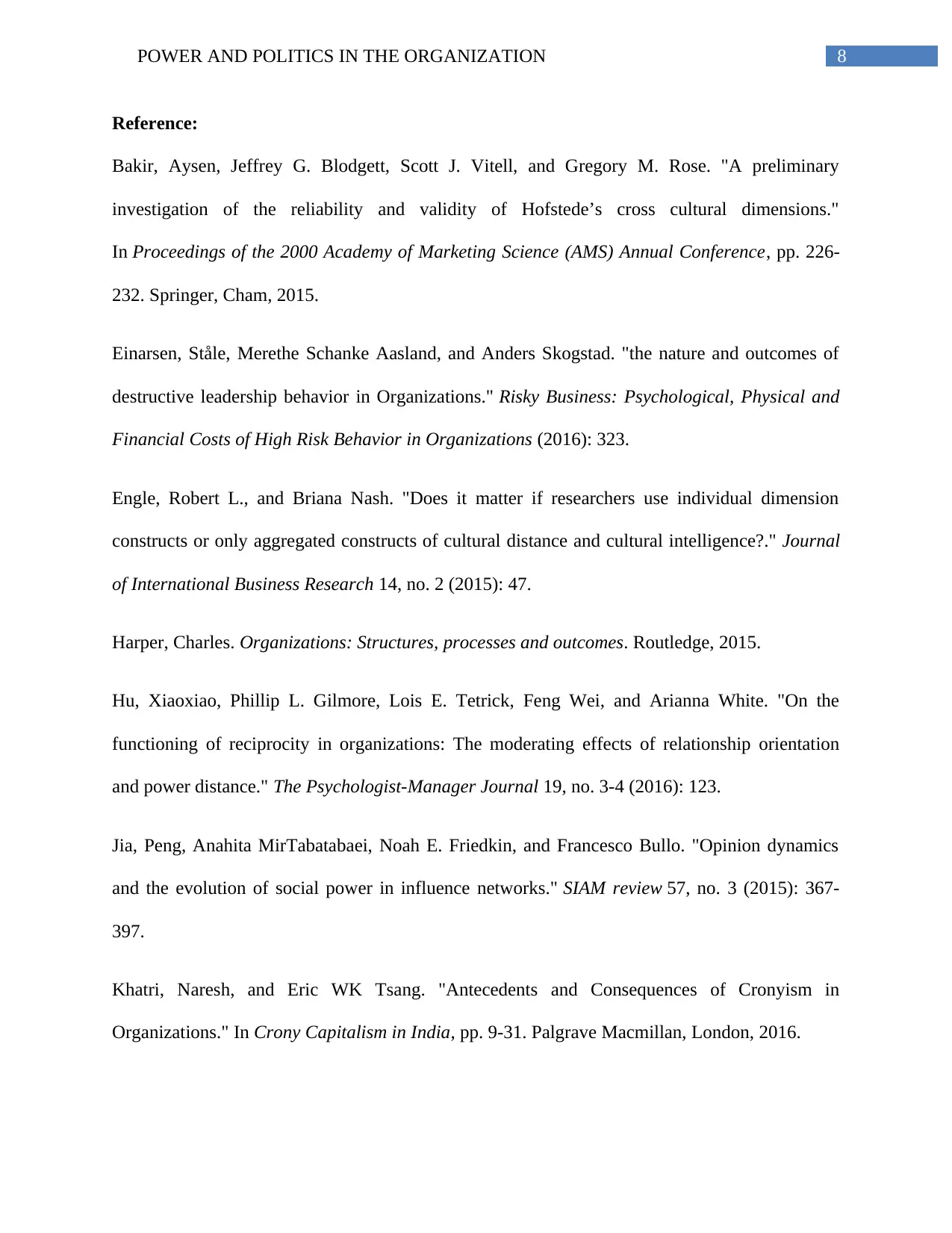
8POWER AND POLITICS IN THE ORGANIZATION
Reference:
Bakir, Aysen, Jeffrey G. Blodgett, Scott J. Vitell, and Gregory M. Rose. "A preliminary
investigation of the reliability and validity of Hofstede’s cross cultural dimensions."
In Proceedings of the 2000 Academy of Marketing Science (AMS) Annual Conference, pp. 226-
232. Springer, Cham, 2015.
Einarsen, Ståle, Merethe Schanke Aasland, and Anders Skogstad. "the nature and outcomes of
destructive leadership behavior in Organizations." Risky Business: Psychological, Physical and
Financial Costs of High Risk Behavior in Organizations (2016): 323.
Engle, Robert L., and Briana Nash. "Does it matter if researchers use individual dimension
constructs or only aggregated constructs of cultural distance and cultural intelligence?." Journal
of International Business Research 14, no. 2 (2015): 47.
Harper, Charles. Organizations: Structures, processes and outcomes. Routledge, 2015.
Hu, Xiaoxiao, Phillip L. Gilmore, Lois E. Tetrick, Feng Wei, and Arianna White. "On the
functioning of reciprocity in organizations: The moderating effects of relationship orientation
and power distance." The Psychologist-Manager Journal 19, no. 3-4 (2016): 123.
Jia, Peng, Anahita MirTabatabaei, Noah E. Friedkin, and Francesco Bullo. "Opinion dynamics
and the evolution of social power in influence networks." SIAM review 57, no. 3 (2015): 367-
397.
Khatri, Naresh, and Eric WK Tsang. "Antecedents and Consequences of Cronyism in
Organizations." In Crony Capitalism in India, pp. 9-31. Palgrave Macmillan, London, 2016.
Reference:
Bakir, Aysen, Jeffrey G. Blodgett, Scott J. Vitell, and Gregory M. Rose. "A preliminary
investigation of the reliability and validity of Hofstede’s cross cultural dimensions."
In Proceedings of the 2000 Academy of Marketing Science (AMS) Annual Conference, pp. 226-
232. Springer, Cham, 2015.
Einarsen, Ståle, Merethe Schanke Aasland, and Anders Skogstad. "the nature and outcomes of
destructive leadership behavior in Organizations." Risky Business: Psychological, Physical and
Financial Costs of High Risk Behavior in Organizations (2016): 323.
Engle, Robert L., and Briana Nash. "Does it matter if researchers use individual dimension
constructs or only aggregated constructs of cultural distance and cultural intelligence?." Journal
of International Business Research 14, no. 2 (2015): 47.
Harper, Charles. Organizations: Structures, processes and outcomes. Routledge, 2015.
Hu, Xiaoxiao, Phillip L. Gilmore, Lois E. Tetrick, Feng Wei, and Arianna White. "On the
functioning of reciprocity in organizations: The moderating effects of relationship orientation
and power distance." The Psychologist-Manager Journal 19, no. 3-4 (2016): 123.
Jia, Peng, Anahita MirTabatabaei, Noah E. Friedkin, and Francesco Bullo. "Opinion dynamics
and the evolution of social power in influence networks." SIAM review 57, no. 3 (2015): 367-
397.
Khatri, Naresh, and Eric WK Tsang. "Antecedents and Consequences of Cronyism in
Organizations." In Crony Capitalism in India, pp. 9-31. Palgrave Macmillan, London, 2016.
⊘ This is a preview!⊘
Do you want full access?
Subscribe today to unlock all pages.

Trusted by 1+ million students worldwide
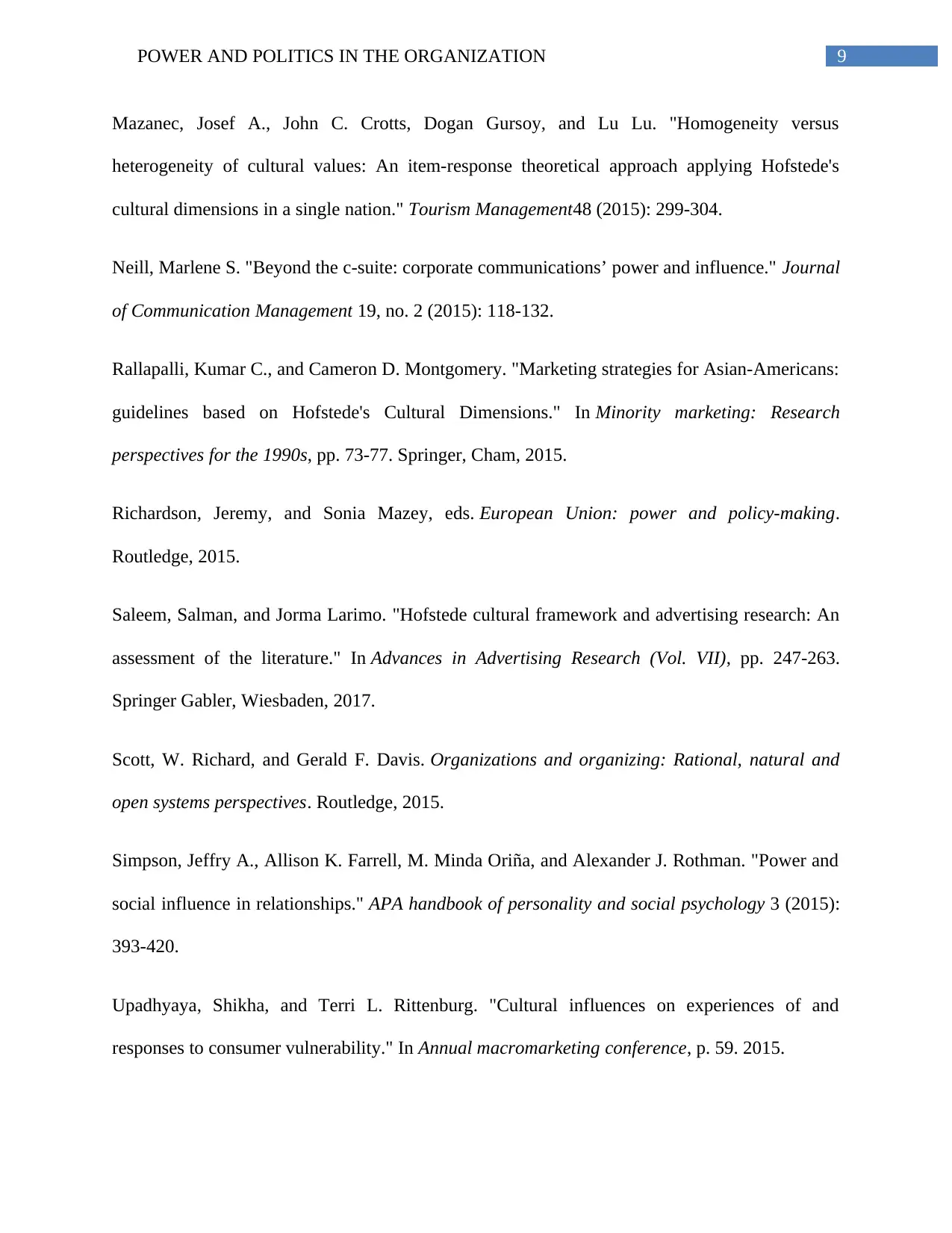
9POWER AND POLITICS IN THE ORGANIZATION
Mazanec, Josef A., John C. Crotts, Dogan Gursoy, and Lu Lu. "Homogeneity versus
heterogeneity of cultural values: An item-response theoretical approach applying Hofstede's
cultural dimensions in a single nation." Tourism Management48 (2015): 299-304.
Neill, Marlene S. "Beyond the c-suite: corporate communications’ power and influence." Journal
of Communication Management 19, no. 2 (2015): 118-132.
Rallapalli, Kumar C., and Cameron D. Montgomery. "Marketing strategies for Asian-Americans:
guidelines based on Hofstede's Cultural Dimensions." In Minority marketing: Research
perspectives for the 1990s, pp. 73-77. Springer, Cham, 2015.
Richardson, Jeremy, and Sonia Mazey, eds. European Union: power and policy-making.
Routledge, 2015.
Saleem, Salman, and Jorma Larimo. "Hofstede cultural framework and advertising research: An
assessment of the literature." In Advances in Advertising Research (Vol. VII), pp. 247-263.
Springer Gabler, Wiesbaden, 2017.
Scott, W. Richard, and Gerald F. Davis. Organizations and organizing: Rational, natural and
open systems perspectives. Routledge, 2015.
Simpson, Jeffry A., Allison K. Farrell, M. Minda Oriña, and Alexander J. Rothman. "Power and
social influence in relationships." APA handbook of personality and social psychology 3 (2015):
393-420.
Upadhyaya, Shikha, and Terri L. Rittenburg. "Cultural influences on experiences of and
responses to consumer vulnerability." In Annual macromarketing conference, p. 59. 2015.
Mazanec, Josef A., John C. Crotts, Dogan Gursoy, and Lu Lu. "Homogeneity versus
heterogeneity of cultural values: An item-response theoretical approach applying Hofstede's
cultural dimensions in a single nation." Tourism Management48 (2015): 299-304.
Neill, Marlene S. "Beyond the c-suite: corporate communications’ power and influence." Journal
of Communication Management 19, no. 2 (2015): 118-132.
Rallapalli, Kumar C., and Cameron D. Montgomery. "Marketing strategies for Asian-Americans:
guidelines based on Hofstede's Cultural Dimensions." In Minority marketing: Research
perspectives for the 1990s, pp. 73-77. Springer, Cham, 2015.
Richardson, Jeremy, and Sonia Mazey, eds. European Union: power and policy-making.
Routledge, 2015.
Saleem, Salman, and Jorma Larimo. "Hofstede cultural framework and advertising research: An
assessment of the literature." In Advances in Advertising Research (Vol. VII), pp. 247-263.
Springer Gabler, Wiesbaden, 2017.
Scott, W. Richard, and Gerald F. Davis. Organizations and organizing: Rational, natural and
open systems perspectives. Routledge, 2015.
Simpson, Jeffry A., Allison K. Farrell, M. Minda Oriña, and Alexander J. Rothman. "Power and
social influence in relationships." APA handbook of personality and social psychology 3 (2015):
393-420.
Upadhyaya, Shikha, and Terri L. Rittenburg. "Cultural influences on experiences of and
responses to consumer vulnerability." In Annual macromarketing conference, p. 59. 2015.
Paraphrase This Document
Need a fresh take? Get an instant paraphrase of this document with our AI Paraphraser
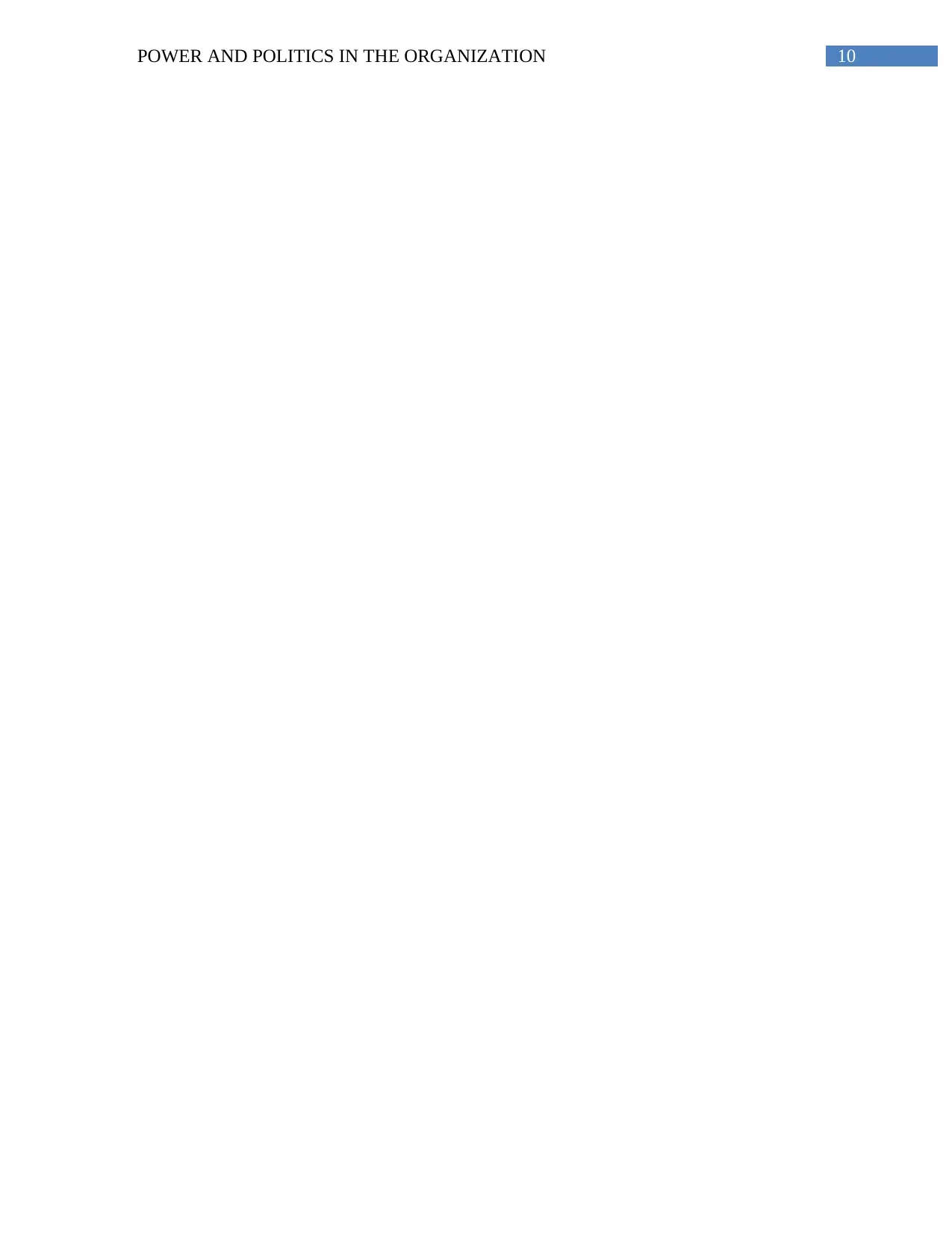
10POWER AND POLITICS IN THE ORGANIZATION
1 out of 11
Related Documents
Your All-in-One AI-Powered Toolkit for Academic Success.
+13062052269
info@desklib.com
Available 24*7 on WhatsApp / Email
![[object Object]](/_next/static/media/star-bottom.7253800d.svg)
Unlock your academic potential
Copyright © 2020–2025 A2Z Services. All Rights Reserved. Developed and managed by ZUCOL.



